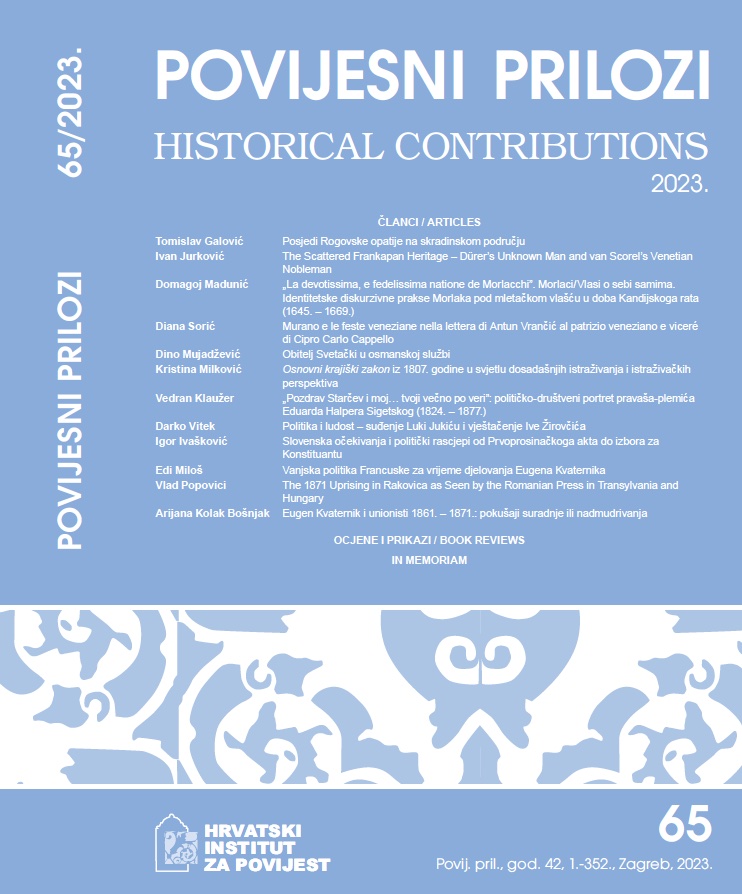Estates of Rogovo Abbey in the Skradin Area
DOI:
https://doi.org/10.22586/pp.v42i65.27861Keywords:
Rogovo Abbey (St. John the Evangelist Monastery in Biograd, Monastery of Sts. Cosmas and Damian on Mount Ćokovac near Tkon on the Island of Pašman), Benedictines, Skradin, Skradin area, Skradin bishopric, Middle AgesAbstract
The Benedictine royal monastery (monasterium regale) of St. John the Evangelist (sancti Iohannis Apostoli et Evangeliste) in Biograd na Moru was founded in the year 1060. After the Venetian destruction of Biograd in 1125 and the relocation of its monks to the nearby island of Pašman, the monastery was renamed after Sts. Cosmas and Damian (monasterii sanctorum Cosme et Damiani de Monte). Due to its largest estate, Rogovo, it was called “rogovski,ˮ encompassing both its historical episodes, the Biograd and Pašman periods. Through the investigation of the topographical and toponymic issues and the ownership relationships of Rogovo Abbey, two main groups of monastery estates were identified: those on the mainland and those on the island part. This work presents the estates that Rogovo Abbey had in the Skradin area (including one mill) and within the jurisdiction of the medieval Skradin Bishopric, for example, in Jošani and Bubnjani. The connections between Skradin and its associated area on one side and Rogovo Abbey on the other date back to the 12th century. In the privilege of Pope Innocent VI in 1358, which takes the monastery of Sts. Cosmas and Damian under the protection of St. Peter and confirms its privileges and all its possessions, two mills are mentioned, one of which is located in Skradin (unum molendinum in Scardona). The same mill is mentioned in the bulls of Pope Lucius III in 1183 and 1188 and in the privilege of Clement III. Skradin's property fits perfectly into the organization of Benedictine monasteries in Western Europe, which regularly had mills in their possession and activities, whether operated manually, by wind, or by water, for milling grain or processing olives. The need for a mill is even stipulated in the Rule of St. Benedict (Regula sancti Benedicti), Chapter 66.
Preserved historical testimonies about the connections and relationships between the Skradin church hierarchy and Rogovo Abbey are not numerous, but what we have sheds interesting light on the subject. In the records of the lawsuit between Skradin Bishop Damian (1303–1309) and Rogovo Abbot Ivan II (1306–1320 /?/) from August 12, 1308, to February 6, 1309, over debts, non-payment of church fees, episcopal tithes, and disrespect for the bishop, it is evident that the excommunication of Rogovo Abbot Ivan II had a significant impact. This severe penalty against Rogovo Abbot Ivan II was proclaimed on December 27, 1308, in the presence of Ban Pavle I Bribirski and his son Juraj II, Bishop Martin of Šibenik, and others. With the fall of Skradin and the broader Skradin area to the Ottomans, Rogovo Abbey lost its estates and rights.
Downloads
Published
How to Cite
Issue
Section
License
Copyright (c) 2023 Authors and journal

This work is licensed under a Creative Commons Attribution-NonCommercial 4.0 International License.







